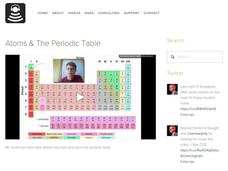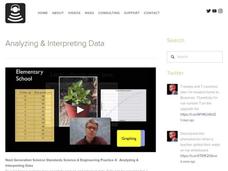Hyperbole Teacher Resources
Hi, What do you want to do?
Find Hyperbole lesson plans and worksheets
Showing 530 resources
Bozeman Science
Position vs Time Graph - Part 2
The narrator os this video explains how to create a velocity-time graph from the position-time graph. He works through several examples after explaining the shapes of the position-time graphs.
Bozeman Science
Animals
For every human in the world, there are one million ants! The instructor shows the phylogenetic tree of animals and where they stand compared to other organisms. The video then focuses on vertebrates and invertebrates, exploring what...
Bozeman Science
Eukarya
Although very diverse, Domain Eukarya is the only domain where the organisms are made of eukaryotic cells. The narrator explores the Domain Eukarya. He discusses the characteristics of eukaryotic cells and shows how these evolved over...
Bozeman Science
Matter
In 1924, Bose and Einstein predicted a fifth state of matter. The prediction proved to be true in 1995 and is referred to as the Bose-Einstein condensation. This video discusses the concept of matter, all five states of matter, and what...
Bozeman Science
Atoms and the Periodic Table
After discovering plutonium, Glenn Seaborg was given the opportunity to determine its periodic symbol. Rather than going with the obvious Pl, he went with Pu as a joke. The designation was approved and is now on every periodic...
Bozeman Science
Beginner's Guide - Balancing Equations
Using impactful visuals and chemical equations, this video describes how to balance chemical equations. It uses examples that are common to the classroom such as methane burning in a Bunsen burner.
Bozeman Science
Limiting Reactants and Percent Yield
Viewers watch while the narrator explains limiting reactions through the familiar example of a recipe. He then describes why it is necessary to use moles to solve these problems rather than just relying on diagrams. The video ends...
Bozeman Science
Acids, Bases and pH
This resource must have a greater concentration of hydroxide ions than hydrogen ions because it makes pH seem basic. The video describes what happens on a molecular level to change the pH of a liquid and focuses on the importance of...
Bozeman Science
Position vs Time Graph - Part 1
Learners investigate the relationship of position with respect to time in a graphical situation and develop an understanding of the slope related to the object in motion. They then use that understanding to create a velocity versus time...
Bozeman Science
Sound Waves
How does that sound look? Teach the characteristics of sound waves through a video lesson that shows an analysis of different frequencies and amplitude of sound waves. The instructor also represents the characteristics of the sound...
Bozeman Science
NGSS: Developing and Using Models
The Next Generation Science Standards list Developing and Using Models as the second science and engineering practice. The video explains conceptual models and the expectations for K-12th grade scholars. It highlights the progression of...
Bozeman Science
NGSS: Asking Questions and Defining Problems
The first practice covered in the Next Generation Science Standards is learning to ask questions and define problems. The video focuses on the similarities and differences between science and engineering focusing on this practice. It...
Bozeman Science
NGSS: Planning and Carrying Out Investigations
The Next Generation Science Standards incorporate planning and carrying out investigations as the third practice. An informative video details how investigations benefit science and engineering, and highlights effective ways to form a...
Bozeman Science
NGSS: Analyzing and Interpreting Data
The third practice in the Next Generation Science Standards applies analyzing and interpreting data. The video explains why this is important to scientists and many different ways to organize data. Then it moves on to discuss how to...
Bozeman Science
NGSS: Using Mathematics and Computational Thinking
The fifth practice in the Next Generation Science Standards covers using mathematics and computational thinking. Scholars and scientists watch a video that explains how they use these skills starting in early elementary, and becoming...
Bozeman Science
NGSS: Constructing Explanations and Designed Solutions
The Next Generation Science Standards list constructing explanations and designing solutions as the sixth practice. The video explains how scientists create and modify theories over time. Then, it offers many examples of scientific...
Bozeman Science
NGSS: Engaging in Argument from Evidence
Learning to engage in arguments based on evidence helps scholars in many subjects. A helpful video explains the importance of this topic and why it is included in the Next Generation Science Standards. It focuses on informal and formal...
Bozeman Science
NGSS: Obtaining, Evaluating and Communicating Information
The Next Generation Science Standards list obtaining, evaluating, and communicating information as the eighth practice. Explaining the importance of reading and understanding scientific information, a video on the NGSS stresses...
Bozeman Science
NGSS: Patterns
The Next Generation Science Standards list the first concept for all disciplines as patterns. Learners view the progression as scholars move from grade to grade and apply these skills in an informative video on the NGSS
Bozeman Science
NGSS: Scale, Proportion and Quantity
Many processes in the universe are either too small and fast or too large and slow to easily observe. The third concept in the Next Generation Science Standards addresses this with lessons on scale, proportion, and quantity. A video...
Bozeman Science
PS1A—Structure and Properties of Matter
It's time we get to the heart of the matter! Explore standard PS1A in an informative video. The narrator guides viewers through the basic ideas of the structure and properties of matter. then discusses helpful strategies...
Bozeman Science
PS1B—Chemical Reactions
Thinking back to the last time you taught a lesson on chemical changes ... was there no reaction? Check out an explosive video to put some spark back in your instruction! The narrator of the video guides you through the...
Bozeman Science
PS1C—Nuclear Processes
Need some strategies for teaching nuclear processes that are sure to cause an explosion of learning in your classroom? Get all the essential background knowledge, plus tips for getting your point across in a thoughtful...
Bozeman Science
PS2A—Forces and Motions
May the force be with you! Learn how to present the content of PS2A, Forces and Motion, using the strategies in the video. With fun scenarios that include Angry Birds and toilet paper, demonstrating the relationship between force, mass,...
Other popular searches
- Hyperbole Examples
- Hyperbole Worksheets
- And Hyperbole
- Hyperboles
- Hyperbole or Exaggeration
- Hyperbole Elementary
- Poetry and Hyperbole
- Hyperbole in Poetry
- Writing Using Hyperbole
- Hyperbole Worksheet 6th
- Idioms and Hyperbole
- Hyperbole Examples Pictures























